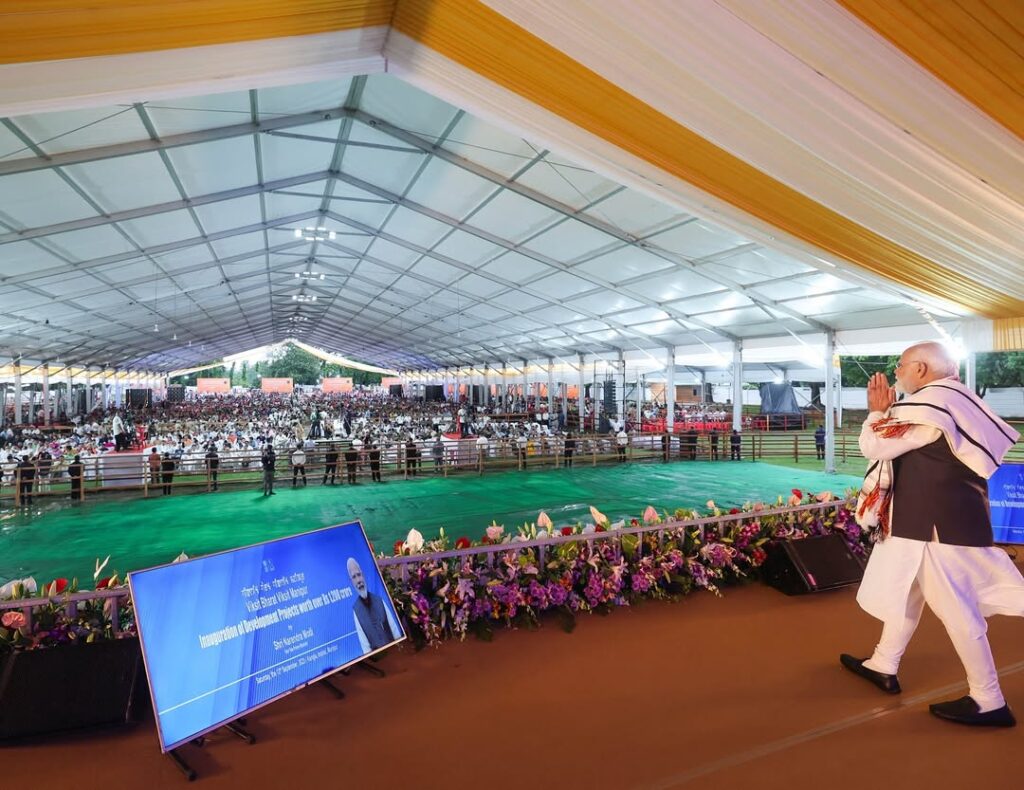Imphal, September 13: On a politically significant tour of Manipur, Prime Minister Narendra Modi combined diplomacy with development on Friday, extending warm congratulations to Nepal’s newly appointed Interim Prime Minister Sushil Karki while also unveiling updates on the ambitious Manipur Railway Project. The move underscored Modi’s trademark blend of regional outreach and domestic growth agenda, signaling India’s intent to strengthen both its Northeast and its ties with its Himalayan neighbor.
A Diplomatic Gesture from Manipur
During his address in Imphal, PM Modi briefly shifted from regional development to regional diplomacy. Congratulating Sushil Karki, who assumed charge as Nepal’s interim leader earlier this week, Modi emphasized India’s “time-tested friendship” with Nepal.
“I extend my heartfelt congratulations to Prime Minister Sushil Karki on taking charge at such an important juncture. India and Nepal share ties of culture, tradition, and destiny. We look forward to working closely with Nepal’s leadership to advance peace, stability, and prosperity in the region,” Modi said.
This remark, though brief, carried weight. It showcased India’s consistent engagement with Nepal despite domestic priorities and reflected Modi’s effort to maintain balance in South Asia’s shifting political climate.
Nepal’s Transition and Why It Matters to India
Sushil Karki’s appointment as interim Prime Minister comes at a time of political flux in Kathmandu, following months of coalition instability. While Nepal continues to navigate internal challenges—from governance issues to economic rebuilding after the pandemic—India remains invested in ensuring a stable and cooperative leadership in its northern neighbor.
For New Delhi, Nepal is not just a neighbor but a partner in connectivity, trade, energy, and security. As the Himalayan state also shares deep cultural ties with India, particularly through Hindu and Buddhist traditions, political transitions in Nepal often draw close attention from South Block. Modi’s congratulatory note was thus both symbolic and strategic, signaling India’s readiness to engage with the new leadership without delay.
The Manipur Backdrop: Why Modi’s Visit Matters
The setting of Modi’s message was just as significant as its content. Manipur, part of India’s restive yet strategically vital Northeast, has been on the Prime Minister’s itinerary multiple times since he came to power in 2014. His visit this week was aimed at reviewing progress on infrastructure projects, addressing security concerns, and reassuring the people of the state amid ongoing ethnic and social tensions.
Among the key highlights of the tour was the Manipur Railway Project, a transformative venture that aims to connect Imphal to the rest of India’s railway grid for the first time in history.
Manipur Railway Project: A Game-Changer
The Jiribam–Imphal railway line, often described as an engineering marvel, was at the center of Modi’s Manipur address. Once completed, it is expected to drastically cut travel time between Manipur and mainland India, boosting trade, tourism, and cultural integration.
Length of the project: About 111 kilometers
Major engineering features: Includes 52 tunnels and 149 bridges
Key landmark: Tunnel No. 12, stretching over 11 kilometers, is set to be the longest railway tunnel in the Northeast.
Expected completion: Targeted for 2025, though portions are already functional.
Modi highlighted the project as part of his government’s “Act East Policy,” which envisions the Northeast as a gateway to Southeast Asia.
“The Manipur Railway Project is not just about connecting tracks; it is about connecting people, cultures, and opportunities. From Imphal, one day, goods and travelers will move seamlessly not just to Delhi or Mumbai but to Myanmar, Thailand, and beyond,” Modi said.
Linking Diplomacy with Development
- Observers noted the symbolism of combining the congratulatory message for Nepal with the railway announcement. For India, Northeast connectivity and Nepal’s political stability are part of a larger regional strategy.
- The railway line strengthens domestic integration while opening doors for future international rail or road corridors to Southeast Asia.
- The message to Nepal ensures India remains engaged at a time when external powers, including China, are vying for influence in Kathmandu.
- By blending the two narratives in Manipur, Modi essentially projected India’s twin priorities: securing its northeastern frontier and maintaining influence in the Himalayan neighborhood.
India–Nepal Relations: A Complex Bond
India and Nepal share an open border of over 1,700 kilometers, allowing unrestricted movement of people. Millions of Nepalis work, study, or reside in India, while cultural and religious ties run deep. Yet, relations have not always been smooth.
In recent years, Nepal’s political shifts and boundary disputes have created strains.
China’s increasing economic footprint in Nepal has raised concerns in New Delhi.
However, both sides have made efforts to repair trust, focusing on trade, energy cooperation, and cross-border connectivity.
Against this backdrop, Modi’s early outreach to Interim Prime Minister Karki can be seen as an attempt to maintain goodwill and prevent geopolitical drift.
The Local Response in Manipur
While Modi’s congratulatory note to Nepal drew attention at the national level, in Manipur the focus remained on the railway project and promises of peace and stability. Crowds in Imphal welcomed the updates, though local voices reminded the Prime Minister of ongoing challenges in the state.
Civil society groups urged the government to ensure that the railway project benefits local communities through employment, fair land acquisition, and cultural preservation. Others highlighted the importance of addressing ethnic tensions and security concerns alongside infrastructure development.
Quotes from Analysts and Experts
Political analysts described Modi’s gesture toward Nepal as a “soft but calculated move.”
Dr. Ramesh Thapa, a Kathmandu-based political scientist:
“India understands the fragility of Nepal’s political landscape. By congratulating Karki from Manipur, Modi sent a message not just to Kathmandu but to the entire region that India values stability in its neighborhood.”
Anita Devi, an Imphal-based economist:
“The railway project will revolutionize the economy of Manipur.” Farmers, craftspeople, and small business owners will be able to access larger markets thanks to it. Here, Modi’s assertion that connectedness is both cultural and economic is resonant.
The Road Ahead
With Interim Prime Minister Sushil Karki now steering Nepal and the Manipur Railway Project nearing completion, both threads of Modi’s Manipur visit highlight India’s forward-looking strategy. The success of this approach, however, will depend on execution:
In Manipur, ensuring the railway project is completed on time, while balancing ecological and social sensitivities.
In Nepal, maintaining consistent diplomatic outreach, irrespective of Kathmandu’s internal changes.
PM Modi’s Manipur visit will be remembered not just for his review of one of India’s most ambitious railway projects but also for his subtle diplomatic gesture toward Nepal. By congratulating Interim Prime Minister Sushil Karki from the Northeast, Modi reaffirmed India’s dual focus on domestic development and neighborhood diplomacy.
As the Manipur Railway Project inches closer to reality and Nepal charts its uncertain political path, Modi’s words sought to weave a narrative of connectivity—of tracks linking Imphal to the mainland, and of traditions binding India and Nepal across borders.
Related News: Read More



